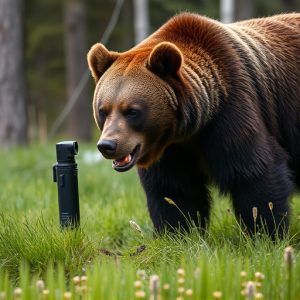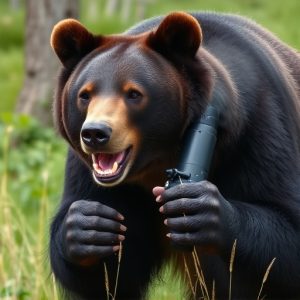Bear Deterrent Spray: Range, Legalities, and Effective Use Guide
Bear spray is a popular self-defense tool against bears, effective due to capsaicin and other chemic…….
Bear spray is a popular self-defense tool against bears, effective due to capsaicin and other chemicals that create an irritant barrier without harming the animal. However, its use varies under local regulations, with some areas—especially national parks—prohibiting or restricting it. Users must research laws and understand environmental factors like terrain and weather for safe and effective use. Choosing a spray with sufficient capsaicin concentration and up to 30-foot range is crucial, along with adhering to local guidelines, including prohibited areas like national parks, where Is bear spray prohibited.
In bear country, having the right protection can mean the difference between a safe hike and a potentially deadly encounter. Bear deterrent spray offers a popular and effective solution, with maximum range playing a crucial role in its success. This article guides you through everything you need to know about bear spray, from understanding its effectiveness and legal considerations (including where it’s prohibited) to choosing the right product and mastering its use.
- Understanding Bear Spray: How It Works and Its Effectiveness
- Legal Considerations: Where Is Bear Spray Allowed and Prohibited?
- Factors Affecting Bear Spray Range and Performance
- Choosing the Right Bear Spray: Key Features to Consider
- Tips for Effective Use: Maximizing Your Protection in Bear Country
Understanding Bear Spray: How It Works and Its Effectiveness
Bear spray, also known as bear deterrent spray, is a powerful tool designed to protect individuals from potential bear encounters in their natural habitat. When used correctly, it can effectively deter bears and minimize the risk of attacks. The spray creates a barrier between the user and the bear by releasing a potent mix of capsaicin, the active ingredient found in chili peppers, and other chemicals into the air. This irritates the bear’s eyes, nose, and respiratory system, causing it to flee the area.
The effectiveness of bear spray lies in its ability to provide a non-lethal means of self-defense. Unlike guns or other lethal deterrents, bear spray allows users to avoid harming the animal while protecting themselves. However, it’s essential to note that bear spray has limitations and may not be prohibited in certain areas where bear encounters are common. Understanding local regulations regarding bear spray is crucial, as some regions have specific guidelines on its use and storage, especially in national parks or wilderness areas where bears roam freely.
Legal Considerations: Where Is Bear Spray Allowed and Prohibited?
Bear spray, also known as bear deterrent spray, is a popular tool for outdoor enthusiasts and individuals living in areas with high bear populations. However, before purchasing and using this potent defense mechanism, it’s crucial to understand legal considerations regarding its usage, especially where it’s allowed or prohibited. The regulations vary significantly across regions, reflecting differing perspectives on wildlife management and public safety.
In many wilderness areas, bear spray is permitted as a means of self-defense against aggressive bears. However, there are strict rules about where and how it can be carried. For instance, in some national parks, bear spray is allowed for personal protection but must be stored properly and used according to specified guidelines. Conversely, certain urban or residential areas may completely prohibit the possession or use of bear spray due to concerns about public safety, potential misuse, or unforeseen consequences within densely populated settings. It’s essential for users to research local laws and regulations before venturing into unknown territories to ensure compliance and contribute to a harmonious coexistence with wildlife.
Factors Affecting Bear Spray Range and Performance
The effectiveness and range of bear deterrent spray can vary significantly depending on several key factors. One of the primary influences is the environment in which it’s used—terrain, vegetation density, and weather conditions all play a role. For instance, in rugged terrain with numerous trees and bushes, the spray’s reach may be shorter due to obstruction, while open areas allow for better dispersion and greater range. Additionally, factors like temperature and humidity can impact the spray’s performance; colder temperatures can make the spray solidify or reduce its volatility, while high humidity might affect the chemical composition of the spray.
Another crucial consideration is the type of bear spray used, as different formulations have varying levels of capsaicin concentration and active ingredients. Bear spray is generally prohibited in some areas due to environmental concerns or regulations specific to wildlife management. Understanding these factors is essential for effective use and safety when encountering bears in their natural habitats.
Choosing the Right Bear Spray: Key Features to Consider
When selecting a bear deterrent spray, understanding its features and limitations is crucial for effective protection in areas where bear encounters are common (such as national parks or backcountry regions). Key factors to consider include the spray’s maximum range—the distance at which it can effectively deter an approaching bear. Look for products with a range of 30 feet or more to ensure you can defend yourself from a safe distance. Additionally, check the type of nozzle; some sprays offer adjustable nozzles for different application methods and precision.
Another important aspect is the spray’s composition and active ingredients. Bear deterrents typically use capsaicin, a compound found in chili peppers, which irritates the bear’s eyes and nose, causing it to retreat. Ensure the product is legal in the areas you plan to visit; regulations vary, and some regions prohibit certain types of bear spray for safety or conservation reasons (where Is bear spray prohibited). Always check local guidelines before heading into bear country.
Tips for Effective Use: Maximizing Your Protection in Bear Country
When using bear deterrent spray, understanding its range and application techniques is key to maximizing protection in bear country. It’s important to note that while bear spray is an effective deterrent, it should be used as a last resort. Always maintain your distance from bears and try to avoid encounters altogether. When deployed correctly, bear spray can create a protective barrier with a range of up to 30 feet (9 meters). Aim for the bear’s face and eyes, as these areas are sensitive, to ensure maximum impact.
Remember that there are specific situations where carrying bear spray is prohibited, such as in national parks or certain backcountry areas. Always check local regulations regarding bear spray use before venturing into bear country. Proper training and familiarity with the spray’s mechanics are also crucial. Practice using it regularly to ensure you can deploy it quickly and effectively during an actual encounter.
Bear deterrent spray is a valuable tool for outdoor enthusiasts navigating bear country, but understanding its range and legal considerations is paramount. By knowing where bear spray is allowed and prohibited, you can ensure maximum protection during your adventures. Keep in mind that factors like wind, terrain, and distance significantly impact the spray’s range, so choosing the right product with suitable features is essential. With proper usage techniques, these sprays offer effective defense against bears, providing peace of mind in potentially dangerous situations. Remember to always check local regulations regarding bear spray possession before venturing into bear-inhabited areas.


